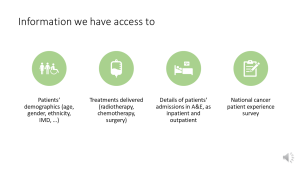About Gliocova



Brain tumours are the leading cause of cancer death in the under-40’s. The commonest malignant tumours are the gliomas – cancers that arise from the “supporting” cells in the brain. Because they are rare, it is difficult to get an accurate feel for what treatment patients have, or what the outcomes of treatment are.
Gliocova is an attempt to use linked national cancer data to understand what the treatment and outcomes for adult patients with glioma are. We use data collected by the English National Cancer Registration and Analysis Service (NCRAS), which links data on incidence, chemotherapy, radiotherapy, surgery, inpatient stays, and dates of diagnosis and death (more on this data here). Gliocova builds on work done by the NCIN’s Brain and CNS tumour group on glioblastoma, surgical outcomes and meningioma.
There are three main strands to Gliocova:
- Descriptive work: A detailed description of what happens, to who, when, and what the outcomes and costs are
- Predictive work: What are the systematic drivers of outcomes? Who lives longer? Who gets admitted to hospital more?
- Patient-Data Integration: How to we integrate patient and carer views with the data we have, to maximise the use of the data, and to tell patients what they want to know?
These three strands then map onto a series of outcomes:
- What type of treatment different patients get
- How often there are complications (e.g. infections, re-admission)
- When and where they die (home/ hospital/ hospice)
- How much their care costs the NHS, and which bit of care costs the most (is it inpatient stay? Chemotherapy? Surgery? A&E Attendances)
This work is driven by several years of conversations around these topics, and questions we and our patients have had over the years that we still cannot answer – for example, how may patients receive 2nd line chemotherapy for a relapsed tumour, and how long do they live for?
Methodologically, we are using a mixture of quite standard approaches (frequencies, regression modelling) and some newer approaches involving network analysis in collaboration with colleagues in the Dept. of Mathematics. One of our interests is looking in outcomes apart form just survival. We are therefore working on adapting existing measures of harm from medical care All the data is stored securely with support from the Big Data and Analytical Unit at Imperial College, and the project has REC and HRA approval.
The project is led by the Computational Oncology group at Imperial College as part of our “Big Cancer Data” theme, but includes a large, multi-disciplinary advisory group, made up of a wide-range of professionals, carers, patients and charity members, and linking to the major professional groups that treat patients with brain tumours in the UK. It is supported by a range of groups, including the Brain Tumour Charity and brainsTrust, and has initial seedcorn funding from the Imperial/ NIHR BRC. Staff members involved are supported by a range of sources, including the Brain Tumour Research Campaign, Imperial College NHS Trust, Imperial College CRUK centre and Brain Tumour Research.
If you would like to know more, please free to get in touch.
Email:
Project Lead: Dr. Matt Williams: matthew.williams
Analytical Lead: Ms. Kerlann Le Calvez: k.le-calvez
Patient & Public lead: Ms. Lillie Pakzad-Shahabi: l.pakzad-shahabi
All email addresses are @imperial.ac.uk
Twitter:
@Matthwilliams
@ResearchTumour
Blog:
https://blogs.imperial.ac.uk/gliocova